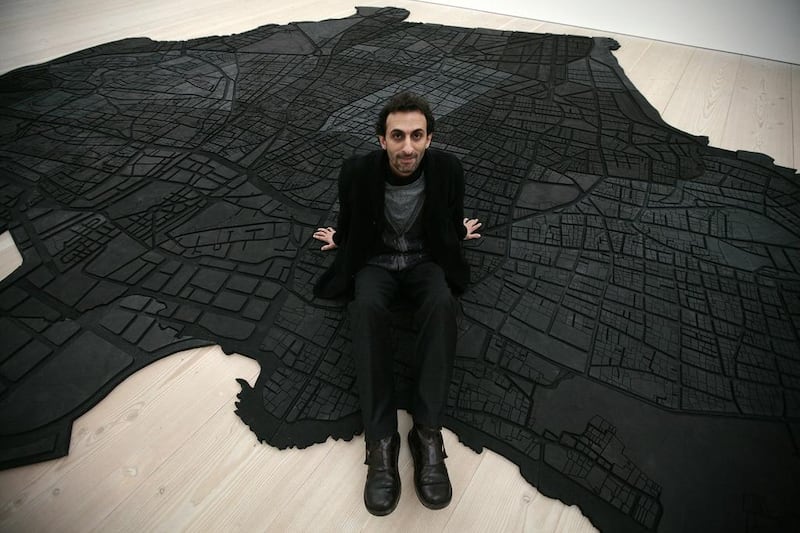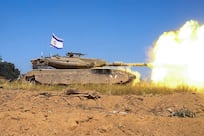On a hectic January afternoon in Beirut, the conceptual artist Marwan Rechmaoui is sitting at a cafe in Mar Mikhael, watching the mad traffic and hustling passers-by outside the window. Rechmaoui has just returned from New York, where he completed a residency at Alwan for the Arts, an association that promotes Middle Eastern art. There, he found himself distressed by the city’s radical changes. “You used to find pimps living on the same floor and entire Puerto Rican neighbourhoods,” says the Beirut-born artist, who studied there during the 1980s. “Now it’s all so corporate and homogenised. Cosmopolitanism is about providing space for exchanges and interaction, and that doesn’t exist anymore.”
The sudden gentrification of the Mar Mikhael section of Beirut also infuriates Rechmaoui. He seldom leaves his home in Hamra and his studio near Jisr el Wati; yet he spends most of his time observing Beirut’s layered social and economic dynamics and what truths they reveal in a country where propaganda and censorship are habitual. Through meticulous research and rigorous observation, Rechmaoui uncovers the ways in which Beirut is shaped and manipulated by religious, economic, political and social forces, offering an alternative reading of the contemporary history of the city. Along with the generation of conceptual artists that thrived in the city after the Lebanese Civil War ended in 1990 (including Akram Zaatari, Lamia Joreige and Walid Raad), he has led the way in questioning the heritage of the colonial and postcolonial eras, crafting an artistic practice that is deeply rooted in local issues while informed by international contemporary art.
For his work Spectre (2006), Rechmaoui erected a replica of the modernist Yacoubian Building where he once lived, reflecting on the waves of changes that have occurred since the building was built, especially after the onset of the war in 1975. While the building was initially a western-style structure with small flats built for the educated middle class, it was increasingly taken over by rural migrants. These new tenants brought their traditions and living habits from their villages, modifying the building’s facade and interiors – adding coloured curtains and gates, sometimes littering common spaces and violating the unwritten rules of so-called civic life in contemporary cities.
For Rechmaoui, the collapse of accepted social norms and the subsequent disorder symbolised the failure of modernism, which promoted rational, organised, sanitised living solutions for crowded cities. The concept had been imported from Europe without any consideration of local needs and customs.
“The urban environment is very hostile,” Rechmaoui tells me. “City-comers cluster together because they are afraid they are facing a new system that they never knew before.
“During the war, some people were raising pigeons and chicken on their balconies, there were tissues and cigarettes flying out the windows. We were witnessing the clash between the provincial and the urban.”
The artist saw the Yacoubian Building as a metaphor for discord and class struggle: “This gap is very important to understand,” he continues, “so that we don’t kill each other. We cannot throw out foreign characters and we cannot ignore them. They are part of the city. But these people are constant enemies and [currently] there’s no space for dialogue.
“This problem is spreading to the whole Middle East: economic problems are creating chasms in society. We cannot deny the other anymore because the other is part of us now – and this is a universal problem.”
Rechmaoui lived in the Yacoubian building before leaving Beirut to study. Upon returning to Lebanon he became active in the art scene, creating public art with the association Ashkal Alwan, a separate organisation from the similarly-named New York centre, and revisiting the art history of Lebanon.
“When we looked at the mythical artists of the 1960s and 70s,” he remembers, “we started aggressively attacking their legacy. Their ideas, ideologies and rigidity led to the war. The artist and intellectual is a mirror of society and the essence of society.”
The young group of artists and curators tried to rewrite Lebanon’s contemporary history, offering alternatives to ever-present political and social tensions. “We felt that we needed to offer something else,” he says. “We started forming Ashkal Alwan in 1994 to manipulate public spaces. We wanted to start a civil society unlike the one that was during the war. There was a need to create a public space to say what we want so that we can be citizens and ask the space for our rights.”
But by the late 1990s, these artists had grown disillusioned by the political and social status quo. “By the time we withdrew, we got to the conclusion that there is no public space in Lebanon,” Rechmaoui explains, “because there are no citizens – there are only dictators and their courts, inflating sectarian and economic riffs in the country.”
Seeking a new language to deal with the tragedy of the war and the deep scars it had left, Rechmaoui began to create semi-abstract paintings where geometric shapes were ordered according to random calculations – an attempt to make sense of the general chaos. He chose the cement, tar and rubber of a country in reconstruction. Slowly, his paintings became structures, increasingly reflecting the physicality of the city.
In the darkly whimsical Beirut Caoutchouc (2004), the artist re-created the cityscape on a gigantic rubber mat, where viewers could search for various neighbourhoods of the city. In the post-war era, debates about the city’s boundaries raged, particularly around a reconstruction project to build motorways that now slice through the urban landscape. Rechmaoui used the signage system created by Électricité du Liban, the public utility that provides electricity, to zone the city into 60 sectors. “The points where neighbourhoods met became barriers rather than meeting points,” he explains. “The [individual] neighbourhoods became places where people felt safest – surrounded by others like them. I wanted to use a soft material that people could kneel on and look closer. It started many discussions on people’s own experience of the city.”
The history of Lebanon is similarly explored in his newest work, Veni, Vidi, Vici (2013), which the Centre Georges Pompidou, Paris, has just purchased. It is composed of 1,000 marble cubes, each measuring seven square centimetres, weighing one tonne in total. Each cube is engraved with the names of the men who erected monuments on the hills of the strategically important Nahr el Kalb in Lebanon, where conquerors and generals have left monuments since the pharaohs. This pile of marble cubes form a white angular mountain. Rechmaoui based the sculpture on Paul Cézanne’s series of cubist paintings of Mont Saint-Victoire at L’Estaque in France; what he calls the most rational moment in art history when colour, light and form came together in the 1880s in radical new ways. “Meanwhile,” he says bitterly, “our own mountain provokes war, because it instigates pride.”
Today, Rechmaoui is still exhilarated by the wild disorder of cities. “We are all strangers in the city,” he says. “That affects people’s behaviour; they become more tolerant, more accepting of new ideas. I like the Baudelairian idea of the flâneur, someone wandering around in the city moving very lightly, but now it’s more complicated with speed or science, for example. Now we are more aware of the social issues connected with cities, with the looming dangers. The possibility of an accident is much higher.”
The recent influx of Syrian refugees in Beirut brings Rechmaoui’s themes of migration and change into sharp relief: “Beirut always grows from the crises in nearby regions. Now that the crises are all around us, Beirut is experiencing massive influxes which will radically change the city again. The infrastructure of the city will be affected and culturally you’ll see changes in the language, the food, the daily habits of people,” he says.
“That’s what I like in the city: it’s always new and it’s about learning something from the other. It’s about discovering new worlds.”
Shirine Saad is a New York-based editor and writer.





